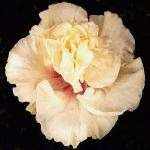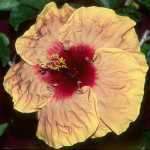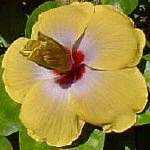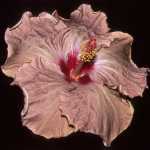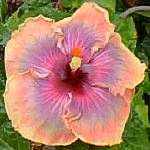|
The tropical hibiscus belongs to the Malvaceae
or mallow family. Other relatives are the
rose-of-sharon (shrubby althea), the hardy hibiscus
grown in the north, okra, cotton, the Confederate
Rose, hollyhock and quite a few others. Further
information is available in The
Tropical Hibiscus Handbook
available thru the American Hibiscus
Society. Some types hibiscus have been used to make
dyes and others have been used as food.
Originating in Asia and the Pacific islands,
Hibiscus rosa-sinensis is the national flower of
Malaysia. It is closely associated with Hawaii,
however the state flower for Hawaii is a native
species of hibiscus, H. brackenridgei. Thousands of
colors and combinations of colors (no true blue or
black), some varieties have blossoms 2" in diameter
and others, 10-12". Some with bushes that will only
grow a foot in several years while others may grow
to 15 feet if left undisturbed in the ground.
Singles, doubles, some blooming almost every day,
the variation in the tropical hibiscus family is
astounding!
Real interest in Hawaii developed around the end of the 19th century. Some plants probably came from
China and were crossed with native Hawaiian
species. Interest spread to the U.S. mainland and
Florida became a center for this interest -- the
Reasoner family being early pioneers. The American
Hibiscus Society was formed in 1950 with Norman
Reasoner as its first president.
Another strong area of organized interest in
hibiscus is Australia. It is thought that they were
introduced there in the early 1800s, but real
interest was sparked later when 30 plants were
imported from India for use in the landscaping of
Brisbane by its city council. The northern parts of
New Zealand also became involved in hibiscus
culture.
If in areas with frost, keep your favorite
grafted hybrids in pots and bring inside. There are
many gardeners who grow all their hibiscus in pots.
These people may live in Texas or even Minnesota
and Ontario and they find ways to successfully grow
and enjoy the tropical hibiscus 12 months a year.
(Please see the page at this
site about growing in non-tropical climes.)
Many of the non-grafted "garden varieties" will
come back from the roots if a frost kills the upper
plant, but these ARE tropical plants.
|

